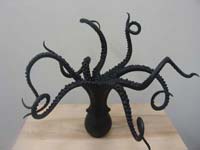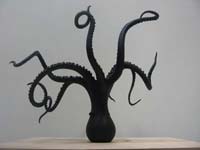|
Also Available:
Show of Hands
November 3 - December 23, 2016
Seattle Magazine, December review:
A 'Show of Hands' for Enduring Seattle Artist, Mark Calderon
Celebrated artist Mark Calderon marks 30 years in Seattle with his 10th solo show at Greg Kucera Gallery
by Florangela Davila
The Seattle Times, November 22 review:
At Greg Kucera, catch 2 Seattle artists at the top of their game
Reviews of two masterful exhibitions at Greg Kucera Gallery: Mark Calderon's "Show of Hands" and Jeffrey Simmons' "Open Work: Recent Watercolors."
by Michael Upchurch
Seattle Met, November 29
A Fiendish Conversation with Mark Calderon
The Seattle artist creates hands of stone and fighters of felt for his new Greg Kucera Gallery exhibit, 'Show of Hands.'
by Seth Sommerfield
Show of Hands
The Fighters focus on the body—its heroic power, agility, expressiveness, and its vulnerability, pain, and ultimate demise. Both images are based on iconic photographs of Muhammad Ali. In exploring the issues of human victory and defeat, I was drawn to work with industrial felt, a soft, warm, and yielding material not typically associated with masculine iconography.
—Mark Calderon
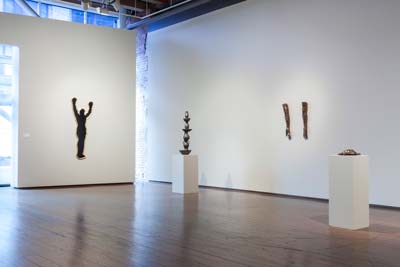  
2016 exhibition, Show of Hands through December 23.
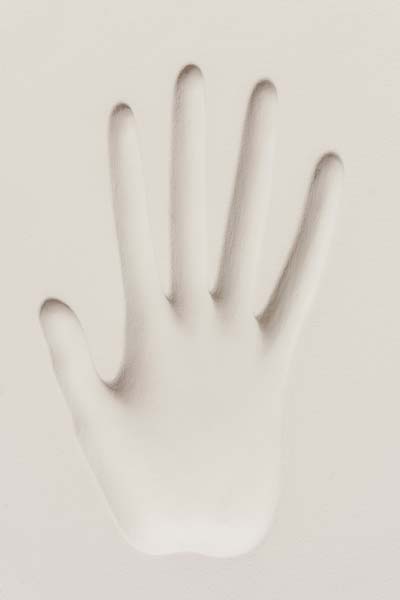
HAND, 2016
Acrylic modified gypsum
8 x 7 x .5 inches
Edition of 3
$2,000
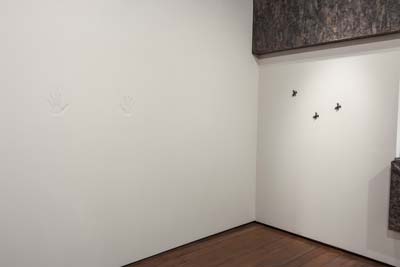
FANNING, 2016 (installation view on left wall)
Acrylic modified gypsum
8 x 33.5 x .25 inches as installed
Edition of 3
$2,500
Additional view of FANNING
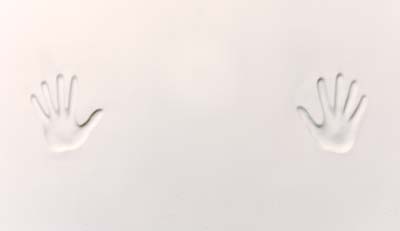
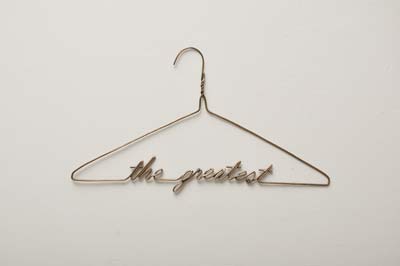
GREATEST, 2015
Cast bronze
9 x 15.75 inches
Edition of 5
Price on request
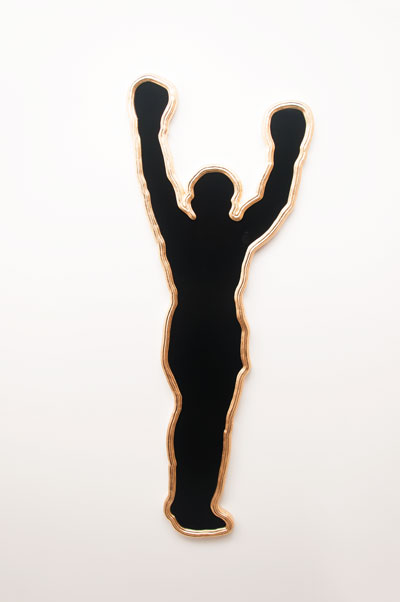
UNTITLED, 2016
Gilded bronze and polycarbonate
62 x 23.5 x 1.25 inches
Edition of 3
$9,000
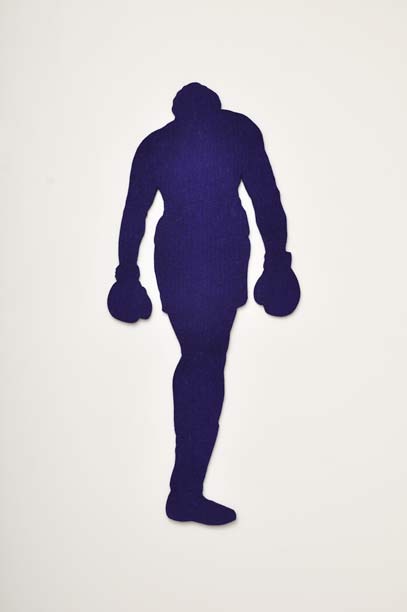
FIGHTER (Blue), 2016
Dyed industrial felt
50 x 23 x .5 inches
Edition of 3
$5,800
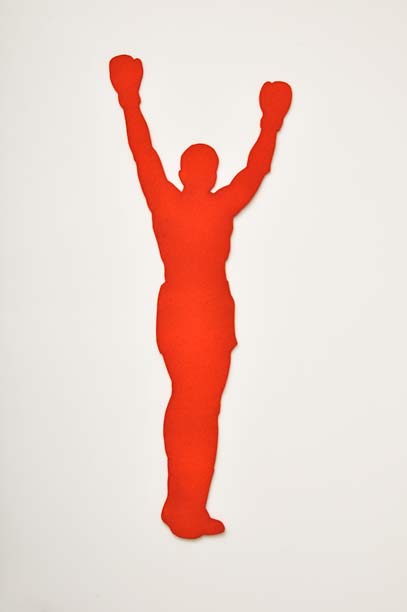
FIGHTER (Orange), 2016
Dyed industrial felt
62 x 22 x .5 inches
Edition of 3
$6,500
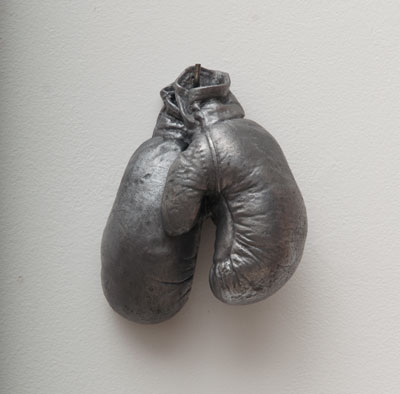
UNTITLED, 2016
Cast lead
5 x 4.25 x 2.25 inches
Edition of 5
Price on request
Show of Hands
I am aware that my hands are always in front of me, so maybe it was inevitable that they would become a subject for my work. The Manus series was created after I cut out a tracing of my hands and forearms, pinned them to my studio wall, and kept looking at them for months as I read and thought about hands as an emblem of human existence and activity. In the prehistoric North American "Hopewell" culture, there is a well-known and beautiful example of a hand, cut from mica. This was the inspiration to use mica for this series. Initially I envisioned them as apparitions from a post-human future--temporary, fading away, powerless, apologetic (Crossed, Protective, Resigned). As I moved through the series the hands became more active, political and about race. In Cry, in which the hands are positioned to amplify the voice, I used a dark amber mica. Reversal of Fortune is based on a painting by Caravaggio called The Fortune Teller in which a wealthy and naive young man is having his palm read by a seemingly innocent girl. While he flirtatiously gazes into her eyes she slips the ring off his finger. In my version it is the lighter-toned hand that plays the deceitful role.
—Mark Calderon

MANUS (Cry), 2016
Mica
12 x 30.5 inches
Edition of 3
$2,500
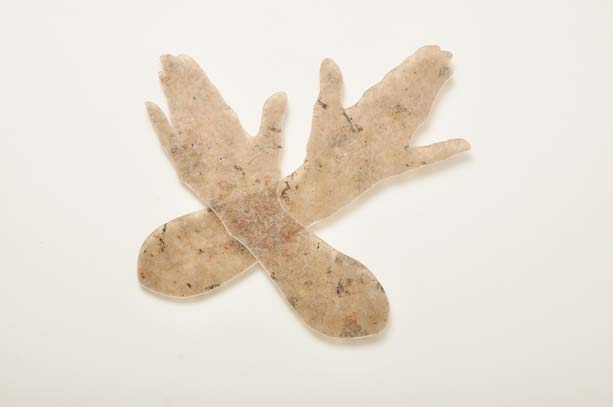
MANUS (Crossed), 2016
Mica
18 x 19 inches
Edition of 3
$2,500

MANUS (Reversal of Fortune), 2016
Mica
10 x 32.5 inches
Edition of 3
$4,000
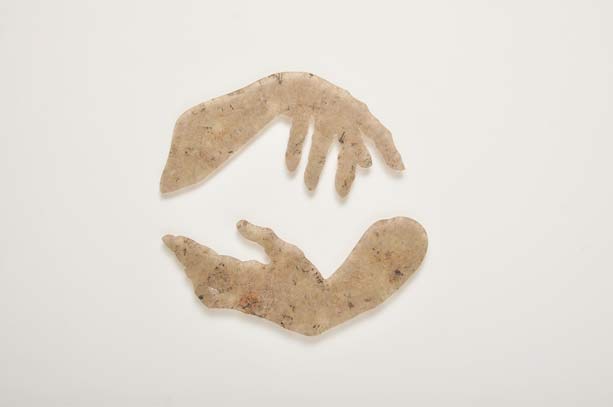
MANUS (Protective), 2016
Mica
18.5 x 19.5 inches
Edition of 3
$2,500
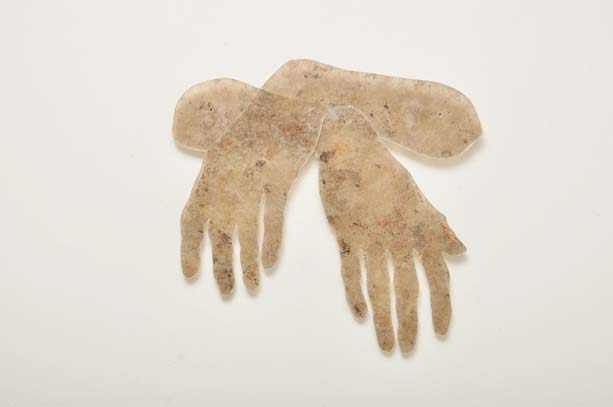
MANUS (Resigned), 2016
Mica
18.5 x 19.5 inches
Edition of 3
$2,500
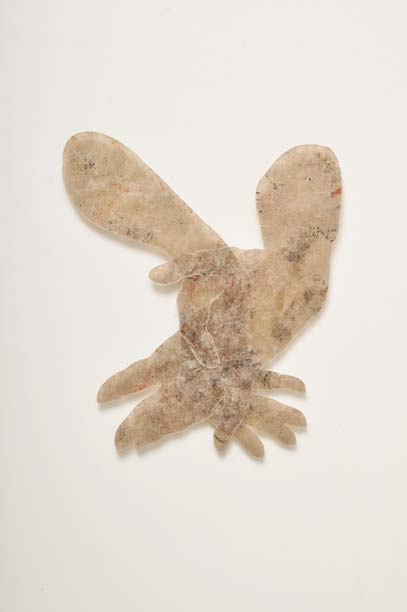
MANUS (Clasped), 2016
Mica
16 x 14 inches
Edition of 3
$2,500
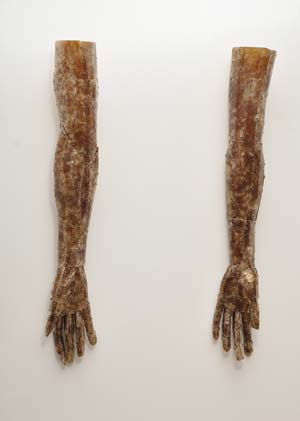
UNTITLED (mica arms), 2016
Mica and waxed thread
29 x 4 x 5 inches each
Unique work
$8,500
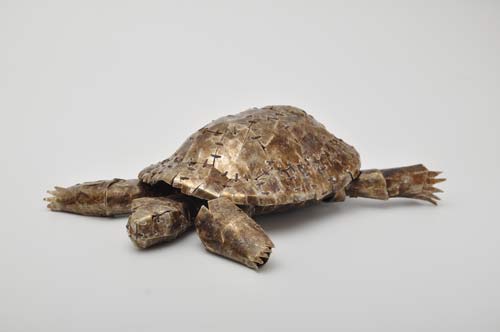
UNTITLED, 2016
Mica, waxed thread
3.25 x 10.5 x 9 inches
Unique work
SOLD
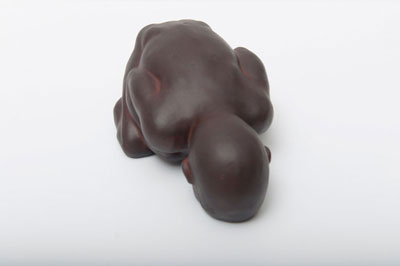 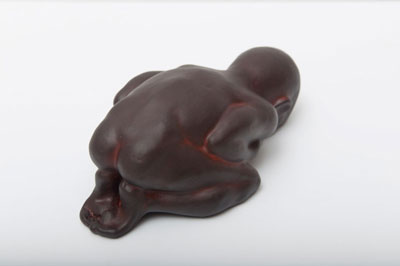
APOLOGY, 2016 - depicted here from two different views
Cast bronze
2.15 x 6.75 x 3.75 inches
Edition of 10
$5,000
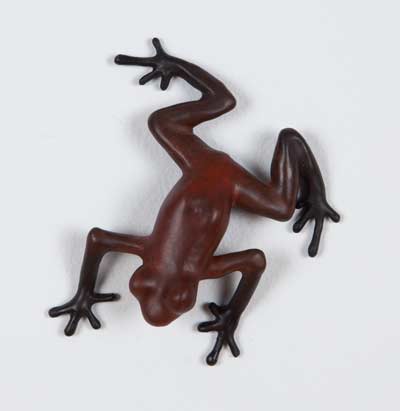
SCOUT, 2015
Cast bronze
3.25 x 3 x 1 inches
Edition of 25
$1,250
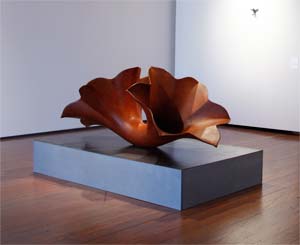
BLAST (double bloom), 2009
34.25 x 43.5 x 80 inches
Cast bronze
Edition of 3
Price on request
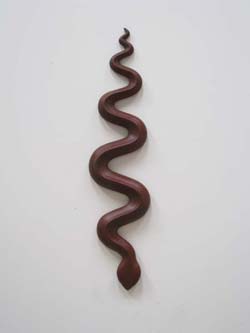
UNTITLED (snake 1), 2009
Cast bronze with patina
36 x 8.5 x 2 inches
Edition of 5
Price on request
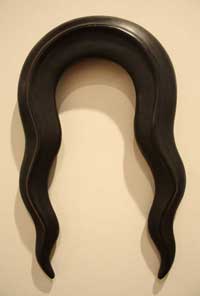
TROPHY, 2008
Cast bronze
26 x 16 x 3.5 inches
Edition of 7
Price on request
NOCTURNE (octopus), 2007
Cast bronze, 23 x 28 x 29 inches
Edition of 8
Price on request
Nature and death have both been recurring themes throughout Calderon’s career, and these recent sculptures draw inspiration from several species of flora and fauna that have become extinct since they were first recorded by humans. The work explores the relationship between these creatures and their environment as well as mankind's use and abuse of that environment.
Much of the work is cast in lead, a base metal carrying dangerous and taboo associations. A hummingbird is caught in frantic mid-flight, coiling snakes suggest the sinuous curves of Arabic calligraphy, skinks intertwine in unknown struggle, and mice rear up on hind legs as if in warning. A large swelling vertical form appears to be shingled in embossed lead panels. Nearby a column of child-sized coffin shapes, made of translucent paraffin, rises from floor to ceiling, reminding us of both life and death and the infinite nature of the latter.
"My influences are many. Some I am aware of, and others still go unrecognized. African sculpture, Japanese aesthetics, Mexican folk arts, nature, personal experience and relationships, family, music, Christian art (both Gothic and Medieval) and other artist's creations, are some major influences I draw from. I do not like to create images that read as only one thing, but try to create works that have both power and mystery."

UNTITLED (snake 2), 2009
Cast lead
28 x 6 x 1.5 inches
Edition of 5
Price on request
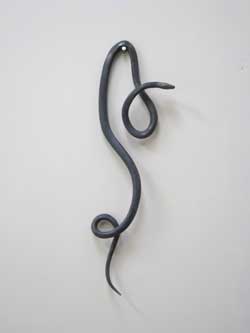
UNTITLED (snake 3), 2009
Cast lead
33 x 11 x 3 inches
Edition of 5
Price on request
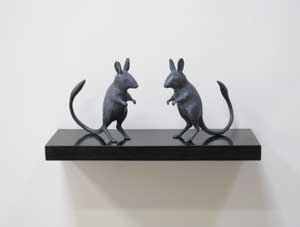
UNTITLED (mice), 2009
Cast lead
6.5 x 7 x 2 inches
Edition of 5
Price on request
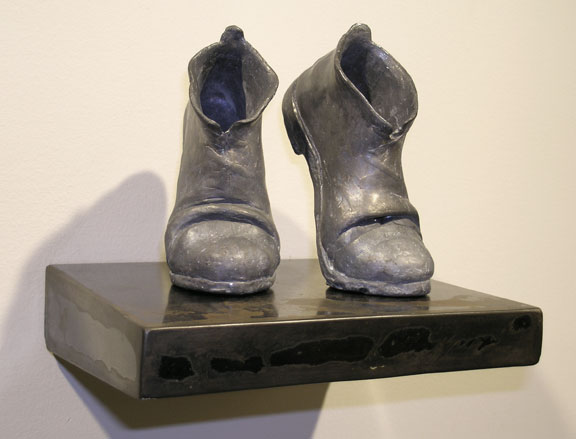
RISE, 2005
Cast lead with steel pedestal, 8 x 8 x 8 inches
Edition of 10
Price on request
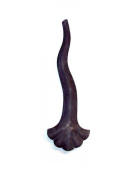
SIRENA, 2004
Lead over modified cement
36 x 11.5 x 3 inches
Edition of 10
Price on request
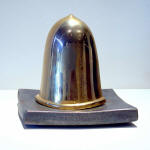 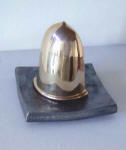
CASCABEL, 2003 (two views of the piece above)
Cast bronze with gold plating on a forged steel base 6 x 5 x 3 inches, base: 1.75 x 6.25 x 6.25 inches Edition of 4
Price on request
Abstractions based on the hair of Buddha - a tightly coiled pattern of curls in one and a topknot in another. Others reflect the graduated cylindrical shape of temples in Southeast Asia, or perhaps a wasp's nest. All of these forms are made of cast gypsum-based cements mixed with acrylics. These have been cast in the artist's own studio and then patinated. The coloration derives from being submerged in various chemical compounds and then exposed to heat prior to application of other chemicals. They are massive looking yet hollow and lightweight enough to hang on a metal bracket on a standard wall. A few similarly heroic scaled works in cast bronze will also be wall-hung, while some more massive works will be situated on the floor.
A smaller cast bronze shelf piece takes the shape of a pair of small crucibles joined together. It has been patinated through the natural evaporation of liquids to form horizontal lines expressing the decreasing levels of chemicals along the inside volume of the shapes.

MANDORLA, 2003
Cast bronze with patina, 31.5 x 14 x 8 inches, Edition of 5
Price on request
Details below:
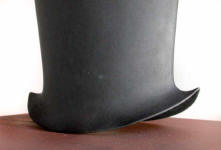 
Calderon's cast bronze pieces using the material to its greatest advantage without succumbing to the seductive qualities inherent in the media. This oversized gourd-like shape relates to Buddha's head and has an undulating leaf-shaped top-knot.
In the past Calderon's work has relied heavily on a distressed, worn or aged-looking surface. In contrast, several of the new sculptures feature a synthetic or industrial looking finish. A few of the pieces were cast in bronze at the Walla Walla Foundry while Calderon worked there on a Residency Grant from Centrum Foundation. Other works involve woven tree bark, brass and lead sheeting, inflated rubber inner tubing, cowhide, pigskin and a curious naturally occurring ball-like shape created by tree branches rolled by waves at the ocean's edge.

MADRINA (bronze), 2001
Cast bronze with patina
57 x 20 x 20 inches
Edition of 5
$35,000
Details below:
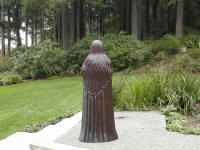  

Also view:
MADRINA (light cement), 2001
Cast modified cement
57 x 20 x 20 inches
$15,000.
Detail of MADRINA:
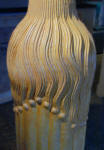
Each work in this edition will be hand finished with a unique patina. A rich reddish brown appears in the crevices of this work.
The image is a reflection on the female figure. Her mystery is evident in the realization that, as the viewer moves around her, a face never appears. Instead, she is shrouded in 360 degrees with long tendrils of curled hair and a gown that is fluted with a scalloped bottom edge. She can be viewed as an abstraction of a Madonna figure but her curls also suggest the Buddhas of the Far East with their pin curls or topknots, and Grecian caryatids with their plaited hair.
"Madrina" is the Spanish word for godmother.
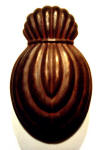
BULLA, 1997
Patinated, cast bronze, 16 x 10 x 7 inches, Edition of 5
Price on request
In 1998 Calderon began to explore the medium of cast cement, as seen in the works illustrated below. All of these forms are made of cast gypsum-based cements mixed with acrylics. These have been cast in the artist’s own studio and then patinated. In this unique process, the artist creates an original object from Styrofoam and wax and forms a rubber mold from the shape. He then produces a "slush-mold" cast employing acrylic-modified cement to which metal powders have been added. The first mold is strengthened with a fiberglass matrix on one side, and the second mold coats the outside with the final layer. This layer is eventually patinated with various chemicals to create a timeworn, subtle finish. The coloration derives from being submerged in various chemical compounds and then exposed to heat prior to application of other chemicals.
They are heavy, solid-looking yet hollow and lightweight enough to hang on a metal bracket on a standard wall.
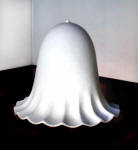
CODA (Large bell), 2003
Cast modified cement 23 x 25.5 x 25.5 inches Edition of 5
$5,000.
Details of CODA below:
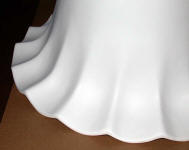 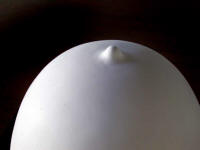 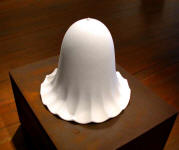 

REGALIS (red), 2001
Cast modified cement, 19.5 x 6 x 4 inches
Multiple of 7, each varies in patina finish
$6,000.
Details of REGALIS (red) below:
 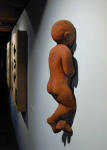
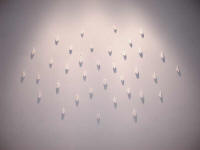
GLORIA, 2003 (suite of 53)
(details of the installation at right)
Cast modified cement
Suite of 36 pieces, 5 x 2.5 inches each, Edition of 5
$8,000.
Details of the installation:
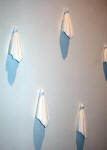 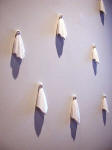  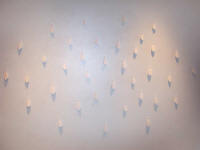
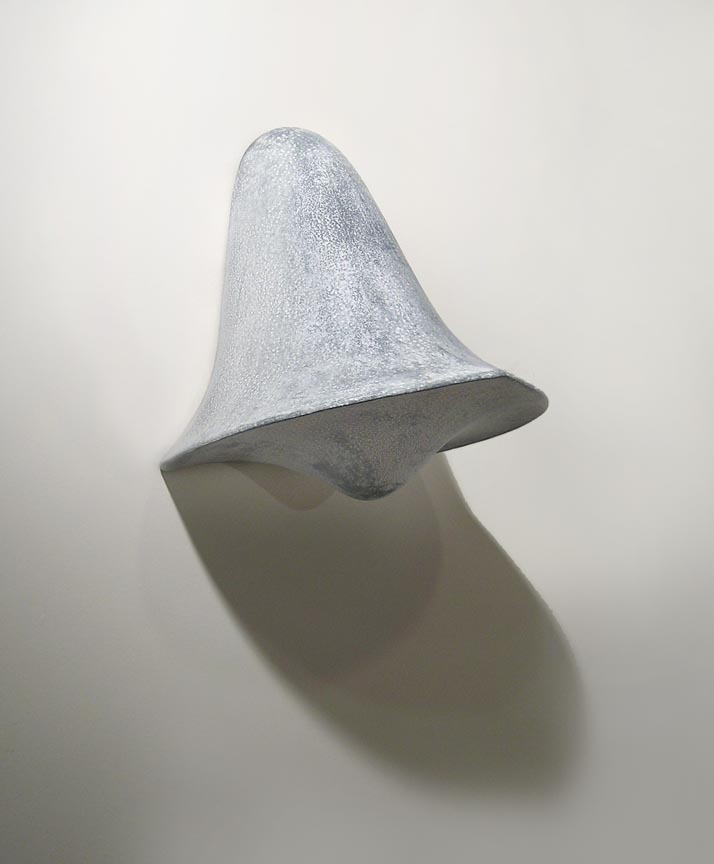
ADOMA, 2003
Lead over modified cement
15 x 13.5 x 13 inches
Edition of 3
$3,500
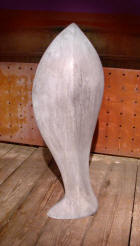
SPUR, 2004
Lead over cast modified cement, 59 x 22 x 15 inches
$9,000.

SIRENA, 2004
Lead over modified cement, 36 x 11.5 inches Edition of 10
$3,200.
Detail below:
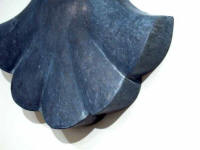
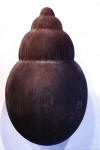
MANA, 1999
Cast modified cement
20 x 12 x 12 inches
Multiple of 5, each varies in patina finish
$3,400.
Many of Calderon's cast cement sculptures reference the somewhat larger-than-life scale of heads from antique statuary of gods and heroes. His previous intimately-scaled work has gained a more heroic reference in this work.
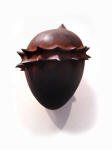 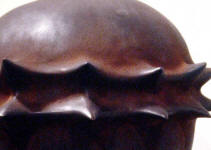
SPINOS (spikes), 1999
Cast modified cement, 12 x 11 x 10.5 inches
Multiple of 10, each varies in patina finish
$2,800.
SPINOS is and abstracted form from a melongena shell from the South Pacific, bears a striking resemblance to previous images relating to a sacred heart with a crown of thorns. The piece has been treated with various copper sulfate solutions and then buffed to bring out a reddish tone over the graphite-colored base.
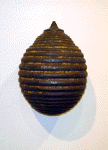
STUPA, 1999 (profile view at right)
Cast modified cement, 18 x 12 x 12 inches
Multiple of 10, each varies inpatina finish
$3,200.
 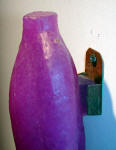
AVIA, 1995 (detail at right)
Kiln-cast glass, 8 x 4.5 x 3 inches, Multiple of 6
$1,800.
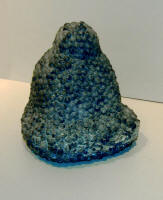 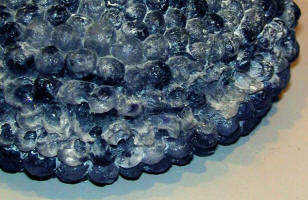
VERUCCA, 1995 (detail at right)
Unique kiln-cast glass, 6.5 x 6 x 6 inches
$2,400.
In 1995 and 1996, Calderon was awarded artist-in-residencies at the Pilchuck School in Stanwood, WA and the Bulls eye Glass Factory in Portland, OR. In his cast glass pieces, the artist attempts to use the material to its greatest advantage without succumbing to the seductive qualities inherent in the medium. Calderon’s wall-mounted and free standing glass works most often take the form of cloudy, translucent jewels through which light enters and refracts, but finds no exit from. In contrast to most delicate, blown glasswork, his pieces achieve a certain solidity and mass in form and through the casting process, attain delicate textures which are both visually and tactilely stimulating.
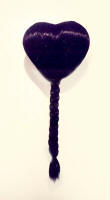
COYUNTURA, 1993
Synthetic hair and mixed media, 34 x 14 x 9 inches
$7,500.

STEMMA (tea leaves), 1990
Tea, blood, cement, steel, 25 x 13 x 1.5 inches, Edition of 5
$6,000.

LEAFLET (burlap), 1989
Mixed media, 54 x 22 x 1.5 inches, Multiple of 6
$4,000.

MILAGRO, 1989
Mixed media, 15.5 x 8.5 inches, Edition of 5
$2,500.

YAM, 1986
Mixed media, 59 x 24 x 16 inches
$10,000.

PLAGUE (warthog skin balls), 1990
Mixed media 62 x 28 x 8 inches
$8,000.
"I was born of a Mexican father and an American mother of Norwegian-Irish descent, and was raised without much specific religious or ethnic influence. Later, during my college studies, I was exposed to many artists and cultures with which I was previously unfamiliar. Only recently have I recognized the influence of the Chicano aesthetic in my work. The rich and varied textures of the materials used in the construction of my work call to mind the important function crafts play in the daily life of the Mexican people. Commonplace materials such as plaster, wood, muslin, steel, tarpaper and cheesecloth are used as integral rather than incidental components of the work and provide a warmth and approachability, which might not be there if I used other media. These materials, often in an old and weathered condition, are an integral part of my work and through the use of these raw and varied textures, I hope to give the pieces an appearance and quality which resists placement in time and position within any specific culture.
The discovery of Victorian mourning jewelry has also made a lasting impression on my work and me. I was fascinated to learn that 100 years ago it was customary to use the hair of a loved one to weave intricate jewelry and decorations as a keepsake or as a memorial. The degree of intimacy that is achieved by using the physical reminders of a loved one is profound. This reinforced my belief that the material and process used can contribute a great deal of meaning to the work.
Much of my work has been quite abstract but recently, I have begun to make direct reference to the rich history Christian images: the cross, the heart, and the torso. These images, so significant in Chicano culture, are for me a representation of individual spirituality rather than the dogmas of any particular religion. For me, spiritual belief and practice is very personal. Nonetheless, the influence was there.
Because of this, my understanding of the creative act has also changed. Originally, I felt my art was affected only by outside influences, quite separate from my life and personal history. As my work and my artistic personality have developed, I began to realize how inseparable they are from my personal heritage."
— Mark Calderon, 1996
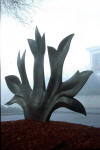 Mark Calderon completed a large-scale bronze outdoor sculpture which was installed at the entry driveway of the Burke Museum at the University of Washington.More recently, Calderon was the recipient of the 2001 Joan Mitchell Foundation Painters and Sculptors Grant. Also this year, Calderon was awarded a public commissions through the Seattle Arts Commission (he also received one in 1994). He has also been the recipient of numerous Seattle Artists awards. Mark Calderon completed a large-scale bronze outdoor sculpture which was installed at the entry driveway of the Burke Museum at the University of Washington.More recently, Calderon was the recipient of the 2001 Joan Mitchell Foundation Painters and Sculptors Grant. Also this year, Calderon was awarded a public commissions through the Seattle Arts Commission (he also received one in 1994). He has also been the recipient of numerous Seattle Artists awards.
Seen above, PLUMA was a commission for the public drive-through space at the entrance to the Burke Museum at the University of Washington in Seattle. The bronze sculpture measures 7 feet tall by 10 feet wide and was installed in 1999.
He received a LEAD, Art in Public Places commission in 1996 and has created public commissions for several community and school projects through the Washington State Art Commission. Calderon has been awarded artist residencies at Walla Walla Foundry in Walla Walla, WA; Bulls eye Glass Factory in Portland, OR; Pilchuck School in Stanwood, WA; and Centrum Foundation in Port Townsend, WA. He has been the recipient of artist grants from Artist Trust, Seattle and Art Matters, NY. The artist was the recipient of the 1993 WESTAF/NEA Regional Fellowship for Visual Arts Award, as well as the Seattle Art Museum's 1986 Betty Bowen Award, an annual award given to a promising young artist of the Northwest.
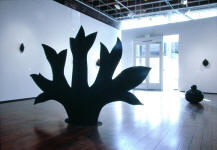
Above is PLUMA installed in Calderon's 1999 exhibition, prior to its permanent installation at the Burke Museum.
Calderon's work is included in several prominent public and private collections, including: Philadelphia Museum of Art, Seattle Art Museum, Microsoft Corporation, Redmond, WA, SAFECO Corporation, Seattle, and Tacoma Art Museum, WA, Boise Art Museum, ID, Clark College, Vancouver, WA, . His sculpture has been featured in a one-person exhibition at Eastern Washington University, Cheney and San Jose State University, as well as in group exhibitions such as the Boise Art Museum's Fabricated Nature, Tacoma Art Museum's Big Objects, and Reencuentros/Reencounters, Museo de Arte Contemporaneo in Chile. Calderon's work has been shown at Jamison/Thomas Gallery in Portland and New York, as well as at Nancy Hoffman Gallery in New York.

FLUME, 1997
Cast iron with graphite finish, 10.5 x 14.5 x 3 inches
$2,400.
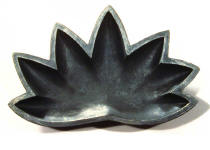
FLORUS, 1997
Cast iron with graphite finish, 9.25 x 14 x 3 inches
$2,400.
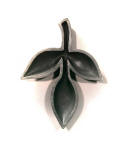
FEMINA, 1997
Cast iron with graphite, 16 x 11.75 x 1.75 inches
$2,400.

COPA, 1997
Cast iron with graphite finish, 9.25 x 14 x 3 inches
$2,400.
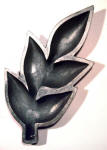
CURA, 1997
Cast iron with graphite finish, 15 x 10.5 x 1.75 inches
$2,400
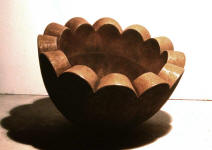
CRONOS, 1996
Flame-sprayed steel shell over Styrene and cement, 27 x 34 x 34 inches
$12,000.
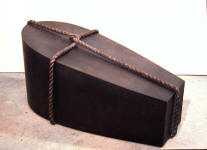
CAVUS, 1996
Steel and rope, 18 x 36 x 19 inches
$3,500.
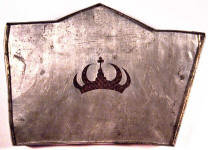
ANGELITO No. 4, 1994
Tin and hair, 8 x 12 inches
$3,400.

BRUNT, 1990
Mixed media, 58 x 40 x 40 inches
$20,000.
BRUNT is a large black rubber balloon inflated within the confines of a metal cage.
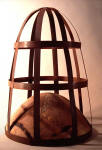
TOFT, 1990
Mixed media, 45 x 32 x 32 inches
$12,000.
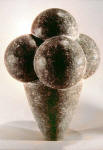
VENUS, 1990
Mixed media, 28 x 20 x 20 inches, $4,800.
 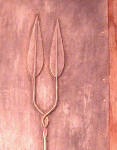
BRIDE MONEY, 1989 (detail at right)
Lead and mixed media, 51 x 25.5 inches, Edition of 5
$900.
"I was born of a Mexican father and an American mother of Norwegian-Irish descent, and was raised without much specific religious or ethnic influence. Later, during my college studies, I was exposed to many artists and cultures with which I was previously unfamiliar. Only recently have I recognized the influence of the Chicano aesthetic in my work. The rich and varied textures of the materials used in the construction of my work call to mind the important function crafts play in the daily life of the Mexican people. Commonplace materials such as plaster, wood, muslin, steel, tarpaper and cheesecloth are used as integral rather than incidental components of the work and provide a warmth and approachability, which might not be there if I used other media. These materials, often in an old and weathered condition, are an integral part of my work and through the use of these raw and varied textures, I hope to give the pieces an appearance and quality which resists placement in time and position within any specific culture.
The discovery of Victorian mourning jewelry has also made a lasting impression on my work and me. I was fascinated to learn that 100 years ago it was customary to use the hair of a loved one to weave intricate jewelry and decorations as a keepsake or as a memorial. The degree of intimacy that is achieved by using the physical reminders of a loved one is profound. This reinforced my belief that the material and process used can contribute a great deal of meaning to the work.
Much of my work has been quite abstract but recently, I have begun to make direct reference to the rich history Christian images: the cross, the heart, and the torso. These images, so significant in Chicano culture, are for me a representation of individual spirituality rather than the dogmas of any particular religion. For me, spiritual belief and practice is very personal. Nonetheless, the influence was there.
Because of this, my understanding of the creative act has also changed. Originally, I felt my art was affected only by outside influences, quite separate from my life and personal history. As my work and my artistic personality have developed, I began to realize how inseparable they are from my personal heritage."
— Mark Calderon, 1996 |


























